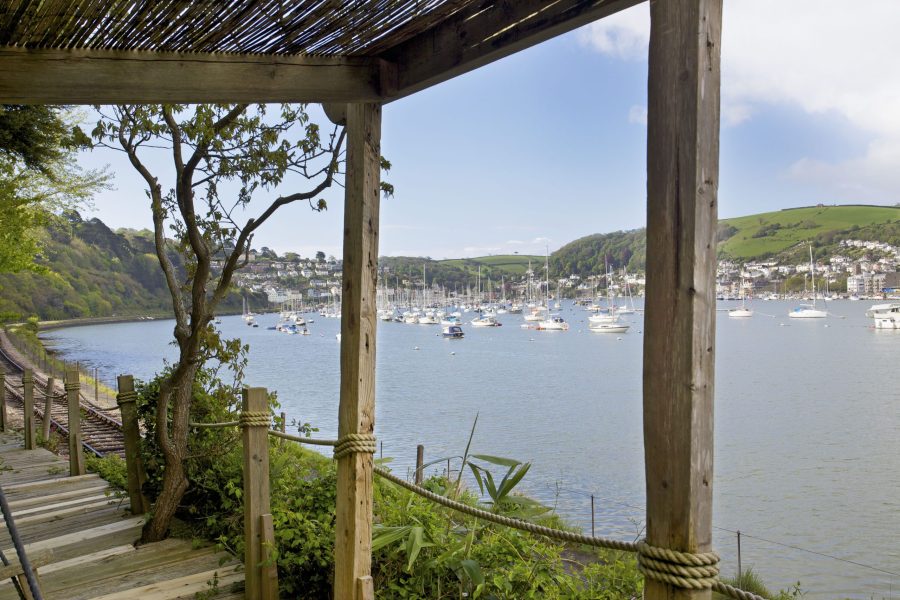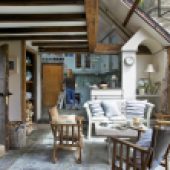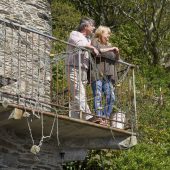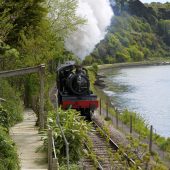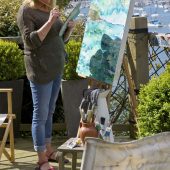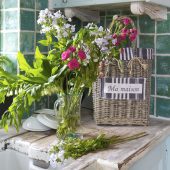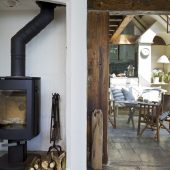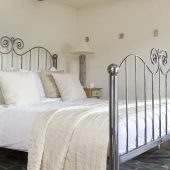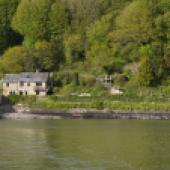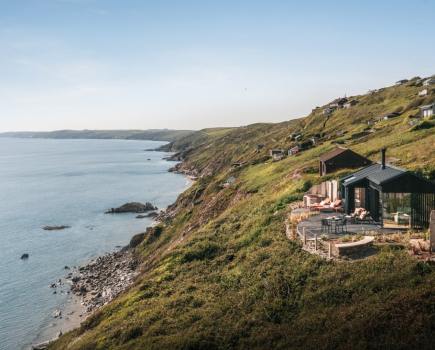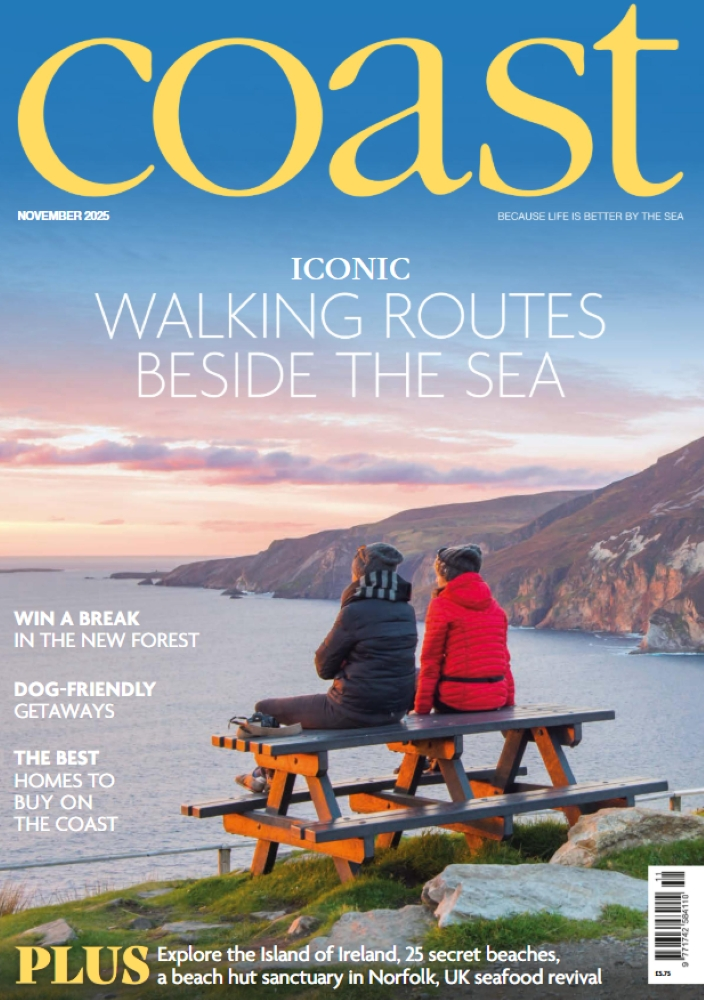This extraordinary house on the River Dart – created almost entirely from reclaimed and salvaged materials – defies description and convention… but has proved a dream come true for its lucky owners. Words: Sharon Parsons. Photographs: Richard Gadsby
Organic, natural, uncontrived…’ Carole Hart Fletcher laughs as she attempts to describe the waterside home she and her husband Robert first lost their hearts to some 13 years ago. But then, how best to sum up the essence of a house that’s somehow so integral to its surroundings you can barely see the join? Nestling at the foot of a steep wooded bank, and reflected in the River Dart flowing in front, QuerQuay (a play on the word ‘quirky’) seems bedded into its landscape – rather than on it – built almost entirely from natural materials that have been salvaged, reclaimed and reborn.
Slate from the cliff face and stone from local beaches are married with weathered wood to create the fabric of the house. Inside, rough plaster walls set off myriad beams and panelling; in the terraced garden, twisted branches and posts tethered with rope are used to edge mossy steps and creaking boardwalks, while meandering pathways lead to unexpected seating areas, a ramshackle hut and a stone-built hideaway.
There’s more than a touch of Swiss Family Robinson ingenuity to this house – and it’s mainly down to the extraordinary vision of one man. ‘The previous owner, John, saw things differently,’ explains Carole. ‘A simple railway cottage originally stood here, but he literally took that down and started again using anything he could find to build it to his own specification, and making as much as he could himself, using little more than his bare hands and traditional methods. It took him 13 years, and was undoubtedly a labour of love.’
MEANT TO BE
Perhaps not surprisingly, it followed that selling the property to Carole and Robert would also take an unusual course. ‘We were living in Derbyshire, but had long dreamed of a bolthole in Devon’s South Hams, which we’d always loved,’ recalls Carole. ‘We agreed, though, that only a waterside property would do, and were prepared to wait years for the right one to come along. I popped in to an estate agent’s to register our interest and were told that, funnily enough, they’d visited a house only the previous evening across the river from Dartmouth in Kingswear.’
‘It’s a bit, well, unusual,’ the agent told them mysteriously, ‘but definitely worth seeing.’
Intrigued, the couple set off to see the house, which sits just beside the upper ferry. ‘When we went inside, we were literally speechless,’ says Carole. ‘Robert and I just looked at each other and knew we had to live here! Everything, from the house itself to the amazing views of the river, the steam train chugging by, and the surrounding countryside was mesmerising.’
The unconventional owner, however, was giving nothing away, and Carole and Robert came away not sure whether or not he was willing to sell his home to them. ‘We’d just got back to Derbyshire when we got a call from the agent to say that John liked us and was happy to go ahead – provided the deal was done and dusted that Friday.’
The pair raced back down to Devon where a complicated negotiating process took place. ‘The agent admitted that the house was so unlike anything else it was difficult to put an exact value on it,’ recalls Carole. ‘We made our offer, and he set off across the river to discuss it with John. Robert and I, meanwhile, sat drinking coffee on the Dartmouth side, anxiously awaiting his return.’
While they did so, they agreed that if their first offer was turned down, they’d dig just a little deeper and put in one final bid. ‘If that was refused, we had no choice but to walk away,’ says Carole. ‘We wrote the sum on a slip of paper, and waited.’
When, eventually, the agent stepped off the ferry with the news that their offer had cut no ice, but that John would let them have it for a slightly higher price, the couple held their breath. ‘When he told us what that was, we simply handed him the piece of paper: right down to the last pound, the figure was exactly the same. We knew then it was meant to be…’
AN EVOLVING STYLE
Once the house was theirs, the couple quickly discovered that – despite its unorthodox appearance – nothing had been designed by accident. ‘Everything is practical and well considered, while the space in the house connects beautifully,’ Carole explains. ‘It appears to be largely open plan, for instance, but each area is framed in some way to offer privacy and cosiness – without compromising on the sense of light or natural flow.
‘We had to make some necessary practical changes like updating the heating system and installing a wood-burning stove,’ she continues, ‘but other than that, all we’ve ever wanted to do is enjoy what was already here.’
Carole and Robert thought carefully about how best to put their own stamp on the place without in any way compromising its integrity. Luckily, their own creative instincts – Carole is an artist and photographer, and Robert a writer – came to the fore.
‘By looking at everything – from décor to furniture – as John would, we found that the look evolved naturally,’ Carole says. ‘We wanted the style to be gently worn and shabby chic, so we’ve distressed furniture, found pieces with a battered history in brocantes and junk shops and even brought weathered items, originally intended for the garden, inside instead.’
Not least, the pair have become expert foragers. Beautifully shaped driftwood found on the little beach in front of the house is displayed alongside bowls of smooth pebbles and shells, their colours and textures contrasting with her striking canvases which are hung on walls and panelling around the house. The overall look – eclectic, simple, casual – is instantly comfortable and relaxed.
Outside, while the informal terraces were already in place, many of the pathways were no more than tracks. ‘We didn’t want to make the garden feel in any way suburban or over-planned – we already loved the way it seemed to merge with the woods above – so we’ve deliberately kept it fairly untamed, simply creating more places to pause and take in the views, like the “poop deck” and the boardwalk that runs beside the railway track,’ Carole says.
A NEW DEVELOPMENT
Four years ago, the couple, who also run their own consultancy business, decided to make QuerQuay their full-time home, throwing themselves into local life with gusto. Despite their busy lives, they were still on the lookout for another project, and found an opportunity waiting, quite literally, underneath them.
‘When John built the house, he also created a self-contained apartment beneath the main house,’ explains Carole. ‘He even designed a wooden staircase which could be dropped down to it for easy access, then lifted again to form the ceiling when not in use. One day we realised the apartment would make a really special holiday retreat – crucially it has its own separate entrance aside from the wooden stairs – so we decided to create just that.’
‘We have never taken this place for granted, but seeing how much others gain from being here is wonderful too,’ says Carole. ‘It’s not unusual to spot a seal popping its head up just in front of the house – once, a shoal of dolphins even went by – and these aren’t things you often see in everyday life.
‘Sometimes, when we sit on the terrace and watch the moon rise slowly over the woods and then reflect on the river, we have to pinch ourselves,’ she admits. ‘We feel as if we’re custodians of a remarkable place. It’s a privilege to be here.’
Carole and Robert’s favourite places:
To eat: The Anchorstone Café. ‘We love taking the ferry boat up to nearby Dittisham, and having lunch at this fabulous café right by the water. It’s so entertaining to watch children crabbing on the quay, and the boats coming and going.’ anchorstonecafe.co.uk
To explore: Blackpool Sands. ‘This magnificent sweep of beach surrounded by cliffs is so inspirational – we go there in all weathers to capture the light and movement of the sea on camera.’
Padstow Harbour. ‘This popular Cornish town has so much to catch the eye – the boats, the water, the colours and textures.’

